#;; 9. THE HERMIT [Alexandra]
Explore tagged Tumblr posts
Text
Charles Leclerc & Alexandra Saint Mleux Relationship Tarot Reading Part 2

Part 1: https://www.tumblr.com/blackcatreadstarot/769135570819661824/charles-leclers-alexandra-saint-mleux?source=share What is the current energy in their relationship? 6 of pentacles, the tower, the emperor, 10 of pentacles, the hermit reversed: they are supportive towards each other because they see that major changes coming their way. They try to control it, so their relationship will still have a solid foundation and be strong. I think that whatever is going on now in their relationship they keep between them. What will happen in their relationship in 2025? knight of swords, ace of swords reversed, 9 of cups reversed, queen of pentacles reversed, 10 of wands reversed, knight of wands reversed: both of them won't do anything to bring something new in their relationship, to bring back love, romance and stability. They both will give up and fail to handle the challenges in their relationship. Again knight of wands is an indicator of passive energy. Also there's possibility that they will move out from each other. Will they break up in 2025? the emperor reversed, 5 of pentacles, 6 of pentacles reversed: more than likely. This is the reading for the current energy. There will be the need for an update few months later. Tarot deck: tarot de luz
#tarot#celebrity tarot#tarot cards#tarot love reading#f1#formula one#formula 1#charles leclerc#charles leclerc tarot#alexandra mleux tarot#alexandra mleux#alexandra saint mleux
21 notes
·
View notes
Text
thinking about that Mechanisms persona 5 au again. The one where it's the mechs cast in p5. So I might as well put who I think should go where.
This is also a college au. I guess. It just fits better
The phantom thieves- the Mechanisms. This is obvious why. They choose the Mechanisms as their phantom thieves group name first, but after a certain someone kept basically saying to everyone that they were the Mechanisms in public, they made the band as a cover and now they have to manufacture beef between themselves as the band and themselves as phantom thieves and that the phantom thieves definitely stole their name.
wildcard- Jonny D'ville. He's the narrator of the Mechanisms and one of the first members of the Mechanisms. He's up there for most roles over all the albums, so wildcard. I'm half tempted to make his persona Prince Charming because one, it would tick him off to no end and two, it the role he as himself played in ouatis.
0 fool - I think Yog Sothoth or one of the elder gods would make the best fit for Yaldy. No idea who Igor would be though
1 magician - the Toy Soldier. It is the least organic of the Mechanisms which is in line with Morgana's origins. I'd say it was given instructions to find the wildcard and eventually found itself in the first Palace pretending to be a Shadow or something. Haven't decided on a persona for it yet though
2 high priestess - Ashes O'Reilly. They have mob connections (though a lot different from how Makoto's went). Ashes would slso manage to become the student president at their college. Their persona would probably be Hades
3 emperor - Raphaella la Cognizi. She and Yusuke are both eccentric weirdos (/pos) in their fields. She has probably neglected herself and her finances in her focus on science as well. Haven't decided on a persona for her yet
4 empress - Nastya Rasputina. A princess and an Heir to a food company are basically the same thing right? (I almost had her be the futaba of the group due to Out, but I figured that being the Haru of the group fit her better. Plus she deserves to be the most terrifying member of the group. And also a big weapon.) Haven't decided on a persona for her yet.
5 Hierophant- Dr. Carmilla (unless I find someone better). She is somewhat of a parental figure? I'm not too sure on this one.
6 the lovers - Gunpowder Tim. His whole thing with bertie parallels Ann's thing with Shiho pretty well.
7 chariot - Baron Marius von Raum. He seems like he would be the most like Ryuji. He does do the talking about the phantom thieves out loud thing which results in them having to make the band as a cover.
8 strength- the Aurora. As the most inhuman of the crew, she gets to be Jonny's attendant in the Velvet Room. They do figure out that something is up with the VR and rescue her much earlier than lavenza gets rescued in p5. (Aurora and Nastya are together in this au still)
9 hermit - Ivy Alexandra. She would definitely be a Navi type.
10 fortune - undecided maybe loki?
11 justice - drumbot Brian. He gets to be akechi due to the whole 2 modes thing, so two personas. To keep in line with his mostly robot thing I am going to make him a anti shadow weapon (think aigis from persona 3)
12 Hanged man- the pendragon trio (or at least arthur). the thing with mordred could be a good parallel between iwai and his kid
13 death- Oedipus. tae and oedipus are both doctors who do kinda have a similar storyline. plus the image of oedipus in tae's outfit kills me
14 temperance - undecided. maybe cinders?
15 devil - Ulysses. Ohya and them have a very similar starting point when we meet them. And Ulysses is a gumshoe (a detective) so that would take the place of ohya's investigative journalism.
16 Tower - undecided. Maybe Heracles?
17 star - undecided. Maybe rose red? Maybe Guinevere?
18 moon - undecided. Maybe pilchard? (Though he'd do better as a Palace ruler or the Shadow that leads them to the second palace)
19 sun - snow white. She and Yoshida both are politicians campaigning for peace and better stuff.
20 judgement- Lyfrassir Edda. They and Sae are both long-suffering people in kaw enforcement who have to deal with the Mechanisms/phantom thieves and all their shenanigans.
#pokemon au#persona 5 au#mechanisms au#p5 mechs au#jonny d'ville#the toy soldier#ashes o'reilly#raphaella la cognizi#nastya rasputina#dr. carmilla#gunpowder tim#marius von raum#ivy alexandria#drumbot brian#Arthur pendragon hnoc#arthur hnoc#guinevere hnoc#Lancelot hnoc#the mechanisms#oedipus udad#ulysses udad#hnoc#snow white ouatis#ouatis#udad#tbi#lyfrassir edda#I'll probably put Palace rulers in the next reblog
14 notes
·
View notes
Text
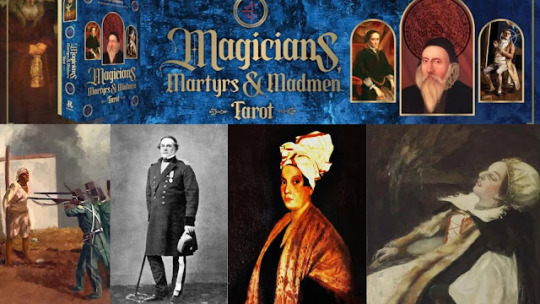
Discover the Magicians, Martyrs and Madmen Tarot Deck
0 - The Fool: James Douglas, The 3rd Marquess of Queensberry Meet James Douglas, the 3rd Marquess of Queensberry, a man characterized as an "imbecile" and "violently insane." Locked away since childhood in Queensberry House in Edinburgh, his life story is as enigmatic as this tarot card.
1 - The Magician: Johann Georg Faust Delve into the world of Johann Georg Faust, commonly known as "Dr. Faustus." He was a scholar and alchemist who made a Faustian pact with the devil, delving into themes of ambition, temptation, and the consequences of selling one's soul.
2 - The High Priestess: Marie Laveau Meet the legendary Marie Laveau, the "Voodoo Queen" of New Orleans, a free woman of color who became a spiritual and community leader through her involvement in Voodoo practices. Her story unfolds in this card.
3 - The Empress: Elizabeth Báthory de Ecsed The infamous "Blood Countess," Elizabeth Báthory, is depicted in all her gruesome glory. Learn about her acts of cruelty and her chilling legacy in this tarot card.
4 - The Emperor: Nero Discover the dark reign of Nero, one of ancient Rome's most infamous emperors. His persecution of Christians and the great fire of Rome are central elements of this card.
5 - The Hierophant: Tomas de Torquemada Tomas de Torquemada, the first Grand Inquisitor of the Spanish Inquisition, stands as a symbol of religious persecution and the fight for orthodoxy. Explore his role in history through this tarot card.
6 - The Lovers: Juliette Bisson, Eva Carrière, Evita & Juan Perón, Sergius and Bacchus This card is a unique blend of historical figures. Juliette Bisson, Eva Carrière, Evita & Juan Perón, and Sergius and Bacchus each bring their distinct stories to the Tarot, encompassing mediums, political figures, and early Christian saints.
7 - The Chariot: Pedro de Alvarado Follow the conquest of Central America and Mexico through the eyes of Spanish conquistador Pedro de Alvarado, a pivotal figure in the history of the Americas.
8 - Strength: Peter Stumpp The infamous German werewolf, Peter Stumpp, takes center stage in this card. His story as one of history's most notorious werewolves is sure to send shivers down your spine.
9 - The Hermit: Edward Kelley Edward Kelley, an English occultist, alchemist, and spirit medium from the late 16th century, invites you into the world of esoteric knowledge.
10 - The Wheel of Fortune: John Dee Explore the mysteries of mathematics, astronomy, and angelic communication alongside John Dee, Queen Elizabeth I's advisor, in this tarot card.
11 - Justice: Matthew Hopkins Meet Matthew Hopkins, the "Witchfinder General," a prominent English witch-hunter during the English Civil War period, as he administers his form of justice.
12 - Ngongo Lutete Discover the compelling story of Ngongo Lutete, a significant Songye leader during the late 19th century, as he rises from enslavement to respected leadership.
13 - Death: Jack the Ripper Unveil the chilling enigma of Jack the Ripper, the unidentified serial killer who terrorized London's Whitechapel district in 1888.
XVIII-THE MOON GREGORI RASPUTIN
Grigori Rasputin, often referred to as Rasputin, was a Russian mystic and confidant of the Romanov family, the ruling family of the Russian Empire. He is one of the most enigmatic and controversial figures in Russian history. Here are some key points about his life:
Early Life: Grigori Rasputin was born in Siberia, Russia, in 1869. He came from a peasant background and was largely uneducated. He worked as a wanderer, sometimes as a religious pilgrim, and later claimed to have had spiritual and mystical experiences.
Rise to Prominence: Rasputin's reputation as a mystic and faith healer spread, and he gained the attention of Tsar Nicholas II and Tsarina Alexandra, who were searching for a cure for their son, Alexei, who suffered from hemophilia. Rasputin's supposed ability to alleviate Alexei's symptoms earned him the trust and favor of the royal family.
Influence on the Romanovs: Rasputin's influence on the Romanovs grew over time. He was often seen as a spiritual advisor and had significant influence over many of their decisions, which led to criticism and controversy.
Controversy and Scandals: Rasputin was widely criticized for his behavior, perceived debauchery, and involvement in political matters. Many Russian nobles and officials viewed him as a charlatan and a threat to the monarchy.
Assassination: Rasputin's influence and scandals provoked deep divisions in the Russian court and society. In December 1916, he was assassinated by a group of nobles who were determined to remove him from the royal family's circle. He was poisoned, shot, and thrown into the Neva River, where his body was later found.
Russian Revolution: Rasputin's murder did not save the Romanov dynasty. The Russian Revolution of 1917 ultimately led to the overthrow of Tsar Nicholas II, the end of the Romanov dynasty, and the establishment of a communist government in Russia.
XX JUDGEMENT - BENDER FAMILY
The Bloody Benders were a family of German immigrants who lived in Labette County, Kansas, in the 1870s. They were notorious for their gruesome crimes, which included robbing and murdering travelers who stopped at their inn, often referred to as the "Bloody Benders' Inn."
The family consisted of John Bender Sr., his wife Elvira Bender, their son John Jr., and daughter Kate. The family operated a small general store and inn, which was conveniently located along the Osage Trail, a popular route for travelers. The Benders would lure travelers to their inn, offer them a meal, and then murder them, often by striking them on the head with a hammer or slitting their throats. Afterward, they would bury the bodies in the garden or basement.
Their crimes went undetected for a time, as travelers often disappeared without a trace, and there were no immediate suspicions of the Benders. However, as more and more people went missing, and rumors of the sinister inn began to circulate, a local investigation was launched.
When authorities searched the property, they discovered several bodies, and it became clear that the Benders were responsible for a string of murders. However, by the time the authorities arrived, the Benders had already fled and were never apprehended.
The Bloody Benders' crimes and their ability to evade capture have made them one of the most infamous and mysterious cases in the history of American crime. The family's gruesome actions have been the subject of numerous books, articles, and works of fiction over the years, and their story continues to be a topic of fascination and horror.
XXI THE WORLD - ALEISTER CROWLEY
Aleister Crowley, whose full name was Edward Alexander Crowley, was a British occultist, writer, and ceremonial magician. He was born on October 12, 1875, in Royal Leamington Spa, England, and died on December 1, 1947. Crowley is one of the most influential and controversial figures in the world of Western esotericism and the occult. Here are some key points about his life and beliefs:
Thelema: Crowley is best known for his role in developing Thelema, a new religious and philosophical movement based on his writings and beliefs. The central tenet of Thelema is "Do what thou wilt shall be the whole of the Law." It emphasizes personal and spiritual freedom, self-discovery, and individual will.
The Book of the Law: Crowley's most famous work is "The Book of the Law" (also known as "Liber AL vel Legis"). He claimed that this book was dictated to him by a spiritual entity named Aiwass in 1904. It serves as the foundational text of Thelema and outlines its core principles.
Occult Organizations: Crowley was a member of several occult organizations, including the Hermetic Order of the Golden Dawn and Ordo Templi Orientis (O.T.O.). He played a prominent role in the development of the O.T.O. and its religious aspects.
Prolific Writer: Crowley was a prolific writer, producing numerous books and essays on occultism, magick, spirituality, and other esoteric subjects. Some of his notable works include "The Book of Thoth" (on tarot), "Magick in Theory and Practice," and "The Equinox" (a series of publications).
Controversy and Notoriety: Crowley's life was marked by controversy and scandal. His libertine lifestyle, recreational drug use, and his public persona as the "Great Beast 666" drew criticism and condemnation from many quarters.
Legacy: Despite the controversies, Aleister Crowley's influence on the modern occult, esoteric, and spiritual movements remains significant. His teachings and writings have inspired many individuals and organizations, and Thelema continues to be practiced by adherents.
Aleister Crowley's life and philosophy continue to be the subject of scholarly study, and his ideas have left a lasting mark on various fields, from spirituality to popular culture. He is considered one of the most important figures in the history of Western occultism.
youtube
Don't miss the chance to add the Magicians, Martyrs, and Madmen Tarot Deck to your collection. Purchase it for £21.75
Your Donations Are Graciously Accepted To Help Me Keep All About Paranormal Online! All About Paranormal is not intended to be for profit, but does carry expenses with domain cost, books, decks, etc. The links I use are affiliate links, I earn a commission for referring you, and the price you pay doesn't change. If you liked my work, please buy me Coffee.


#unboxing#tarot#Youtube#themagiciansMartyrsandMadmenTarotDeck#tarotunboxing#walkthrough#flipthrough#tarotcards#tarotdecks#divination
1 note
·
View note
Text

“Funny, running into you here . .”
0 notes
Text
Nice Jewish Girl Runs Away From Home, Becomes Tantric Lama
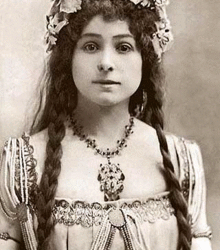
Alexandra David-Neél was a Franco-Belgian singer, explorer, author and Tibetan Mystic who became a Tantric Lama. ��She was the first westerner to visit the forbidden city of Lhasa in the year 1916. Long before Heinrich Harrar spent his 7 years in Tibet making nice with the Dalai Lama, Alexandra had been there, done that, and why her life has never been immortalized on film remains a mystery that only the Hollywood patriarchy can answer. She wrote over 30 books covering the subjects of Buddhism, Tibetan Tantra and Esotericism and that’s just for starters.She was also a much accomplished and sought after translator, being fluent in French, English, Sanskrit and Tibetan. Sadly, only two of her books are still in print today: “My Journey To Lhasa” and “Magic and Mystery in Tibet”. Alexandra lived to the age of 101 and to this day remains the most authoritative source for Tibetan Tantric Buddhism.
Alexandra was born in Paris, October 24, 1868 to an anarchist father who nearly escaped execution by firing squad after the failed revolt of the Paris Commune and a mother who was a deeply religious, conservative heiress. This social incompatibility led to many arguments between the parents during Alexandra’s formative years. No doubt this created a pattern in her life of wanting to runaway from conflict and instilled a desire to find balance through travel. Her earliest attempt to runaway was at the 5, she only got as far as the local park before the Gendarmes found her and promptly returned her home. This was the first of many attempts to runaway until she reached adulthood and was able to claim her inheritance; allowing her to satisfy her wanderlust. I myself being a product of a dysfunctional upbringing, related to many of her situations, which made her story to be particularly compelling on a very personal level.
Throughout her childhood and adolescence, she would find the opportunities to escape her bourgeois surroundings in search of adventure: While vacationing with her parents Belgium, she ran away to the Netherlands, was found and returned home. Later that same year, she embarked on a bicycle trip from Paris to Spain, “forgetting” to tell her parents, naturally. But perhaps her most ambitious and successful attempt to fly the coup was at age 17, when she boarded a train from Brussels to Switzerland, hiked across the Alps where she wound up in Lake Maggiore, on the Italian side of the Alps. This last escapade was certainly a primer for her future adventures in the Himalayas. As she loved to say about herself: “I learned to run before I could walk”.
When she turned 21, she moved out on her own and set herself up in Paris, where she enrolled in the Paris Conservatory of Music while at the same time began to study esoteric traditions with the well known mystic of her times, Madame Blavatsky. She also discovered Paris’ venerable museum to Asian art and culture: Le Musée Guimet; which still exists today. It was here that she fed her hunger for exotic cultures, traditions and converted to Buddhism. Right around this time Alexandra received her inheritance and she flew the coup once again, this time to India. She traveled through India, studying Sanskrit, visiting temples until she ran out of money and returned to Paris.
Upon her return to Paris, she sadly discovered that her desire to share the experiences of her visit was met with antipathy. Since women did not do those things and studies of other cultures were done from an observers point of view. Not as Alexandra had done, as a participant. Needing to find gainful employment, she fell back on her earlier training in voice to pursue a career as an opera singer. As a singer she achieved a fairly acceptable amount of success, traveling the world and finally landing a permanent residency at the Saigon Opera. She even found the time to compose an Opera herself! She continued traveling the world and while performing a gig in Tunisia, she met the man who was to become her husband and would be the facilitator of some of her greatest adventures. Philippe Neel was a civil engineer who worked for the government of France and like Alexandra was extensively well traveled as a result of his job. Together they had an unconventional marriage by the norms of the times. It could be called an “open marriage” but open only in the sense it was Philippe’s support of her travels that facilitated some of Alexandra’s greatest adventures. But let’s not confuse Philippe for a pushover, because underneath all the generosity was an ulterior motive: Philippe also had a mistress and dispatching his wife off to yet another globe trotting mission kept her out of the way. All evidence suggests that Alexandra was ok with this and chose to look the other way.
The Ultimate Late Bloomer:
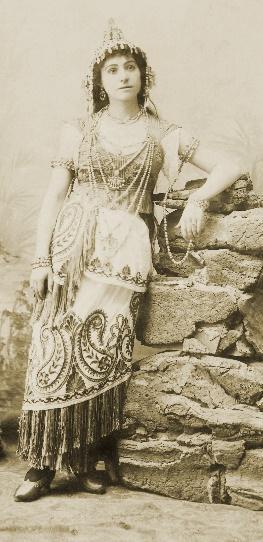
On August 9, 1911, with her husband’s blessing, Alexandra returned to India. She told her husband she would return in a few months. She would be gone for 14 years. But during all this time Philippe was supportive both emotionally and financially. The letter between them prove this. Even though there was little physical connection between them, their correspondence reveals a strong intellectual connection and more importantly, a heart connection.
Upon arriving in India she travelled north to the Himalayan Kingdom of Sikkim where she was a guest of Maharaja. Here she met the Dalai Lama, whose only advice for her was “Learn Tibetan!” and a great Buddhist mystic named Lachen Gomshen Rinpoche (more about him later). In one of the monasteries she met a teenager named Lama Yuphur Yongden who would become her lifelong companion and whom she would eventually adopt as her son. The proximity of Sikkim to the Tibetan border sparked Alexandra’s desire to visit the forbidden city of Lhasa, which was closed to Westerners. But with no success; she did cross the border illegally a few times but was turned away.
During her mentorship with Gomshen, she lived in an anchorite cave. Essentially as a hermit, practicing yoga, Tibetan Tantra and the study of Buddhist Scriptures. So accomplished did she become in her studies that she was awarded the title of “Lamani” (female Lama) and “Kadoma” a reincarnated female spirit. As a result of this she was allowed to wear the sacred red and white vestments of a Lama as depicted in the pictures here.
On July 18, 1916, she once again attempted to illegally enter Tibet, hoping to make it to Lhasa. She did manage to visit a few important monasteries and struck up a friendship with the Panchan Lama and his mother. She was given an honorary Doctorate in Tibetan Buddhism by the Panchan Lama, who wanted her to stay on as his guest. But Alexandra refused, wanting to return to Sikkim. This was to prove to be a great error on her part. Once she returned to Sikkim, she learned that her actions had sparked the ire of the British Colonial Authorities. Remember ant this point in time, Sikkim, India and the rest of the kingdoms of the subcontinent were under British colonial rule and travel to Tibet was forbidden. So consequently poor Alexandra was kicked out of the country.
This began Alexandra’s Iliad through the countries of Asia. Since WW1 was raging throughout Europe, it was too dangerous to go back. Instead she headed east, visiting China, Japan, Korea, and Mongolia with the faithful Yongden at her side. Determined to return to Lhasa, she and Yongden devised a plan where they would attempt to enter Tibet by traveling from Mongolia, via the northern deserts through the shared border of China and Tibet. In order to make her entrance with as little fanfare as possible (it’s obvious by now that Alexandra had a flare for the obvious) she darkened her skin with soot, dressed in rags and passed herself off as Yongden’s mother. A foreshadowing of things to come. This time her journey was a success, by now it was 1924 Alexandra had now been wandering the face of the earth for almost 14 years. Even though she had achieved a personal Nirvana, Alexandra felt the need to return home. So she packed up and returned to France with her companion Yongden in tow and returned to France
Inner Iliad/Outer Odyssey:
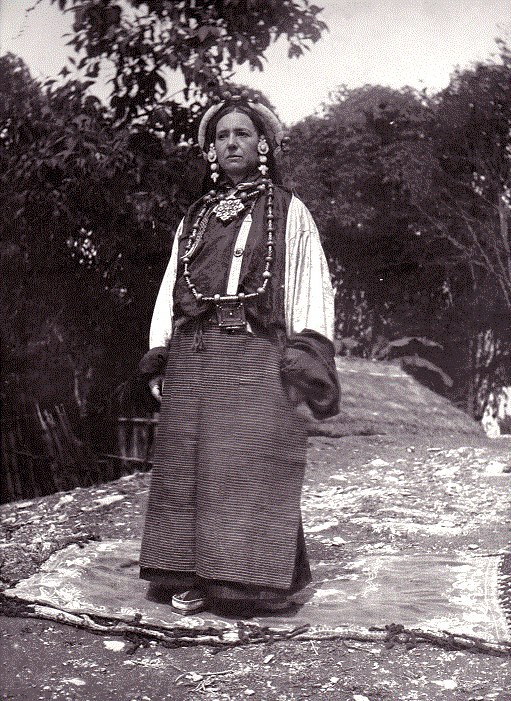
Upon her arrival in France, Alexandra discovered that she had attained something of a celebrity status in France, due to her writings, translations of Buddhists manuscripts and reports of her adventures in popular magazines. She wound up settling down in the village of Digne-les-Bains in the region of Provence. She earned a reputation as a Buddhist scholar of record. The accounts of her adventures were published in many of the major newspapers and magazines of the day. It was here that she wrote her book “Magic and Mystery of Tibet”. She worked on expanding the property and by all accounts created the first Tibetan Tantric temple in the western hemisphere.
During this period of her life from 1925 to 1937 that she began what I like to call her “Inner Odyssey”. Alexandra had clocked in more travel miles than most of her contemporaries an amazing feat for anyone back then, in particular a woman. The origins of her wanderlust began as a way of escaping from her dysfunctional past. As she progressed on her outer journey to forbidden lands, she also began a journey of inner exploration in a quest to find balance. Through the study of ancient and sacred texts, she was able to shed her outer shell to realize to achieve a personal nirvana and become a “Lamani”.
In her book, “Magic and Mystery in Tibet” she recounts many unexplainable phenomena which may appear to be inconceivable to the average Westerner. Some of which are explained here:
Tummo: The ability to control the temperature of your body. This technique came in handy for Alexandra and her companions as they hiked through the Himalayas. Since they often traveled by foot or by horse and on a shoe string budget, learning to control your body’s temperature for personal warmth or to start a campfire would become a mainstay survival technique throughout her travels.
Tulpa: This is not to be confused with the western concept of an Egregore or a Golem. A Tulpa is the creation of a physical being through one’s own thought process. In order to survive under dangerous conditions while trekking through the Himalayas, Alexandra recalls creating Tulpas to serve as her guides and to endeavor protection. Apparently none of these emanations survived for more than a few days according to her.
Bardo Thödel: A death and rebirth ritual in which the Lamas have the ability to die, and in doing so their spirits would leave their physical body and then return at will. This was accomplished by the insertion of a thin bamboo reed or straw into the fontanelle of the skull. This straw or reed would serve as a conduit for Spirit to exit and enter the body, once the magical words had been uttered. These magical words (which I will not disclose here) were also uttered when a Lama would be midwifing a transition of a human from this existence to the next Bardo. In other words, serving as a guide for them at the time of death.
Flying Yogis/Levitating Yogis: In her book “Magic and Mystery in Tibet”, she describes seeing yogis with the ability to levitate or even fly through the air to get from point A to point B. There has been much speculation about this phenomena in particular especially since many Indian Fakirs have been discredited when it was discovered that they were creating the illusion of levitation by relying on a specially rigged chair disguised with cloaks. But what Alexandra describes in her book is nothing of the sort; She witnessed grown men flying across open fields with out any visible means of support.
To the average westerner, these anecdotes may border on the delusional or ridiculous. And yes they sometimes they are a bit difficult to believe. But keep in mind of the environment and culture that produced these assertions: They were produced in the rarified air of Himalayan Kingdoms that are free of are western distractions such as internet, cell phones, televisions, traffic, unhealthy foods. These “modern conveniences” that are more of an addiction than a convenience. There the mind is free of distractions and free to manifest at will. To paraphrase Alexandra: Our thoughts manifest our reality, and the mind that is free of distractions can manifest anything. So there is no doubt in my mind that she used these techniques not only to expand her knowledge of to also heal from her fractured past, make herself whole and to impart healing to others.
Her Relevance Today’s World:
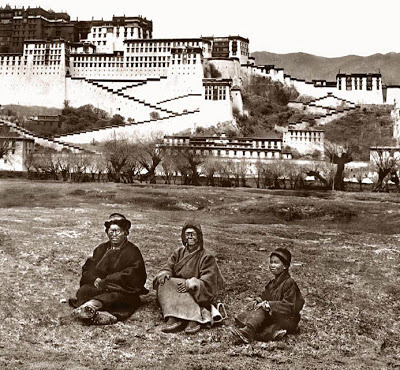
So again, to the Western mind these recollections would seem improbable, but I am here too say that one needs to take themselves out our linear Occidental mindset and learn how to appreciate how these techniques can be applied to our own urban enlightenment. The Tantric Yogis may have had the capacity to fly through the air but they would probably shrink in horror at the thought of us climbing into a big metal bird that flies through the sky. We may laugh at yogis inserting straws into their skulls in order to experience life and rebirth, but how about her modern medical traditions that keep people alive through organ transplants or defibrillation when in some cases the patient may be way past their time to transition?
Our society today is fractured, some say way beyond repair. But I refuse to subscribe to that opinion. Because if these teaching that have existed for thousands of years before our current western traditions, then they will still continue to flourish long after our ministries have been reduced to dust. Today there are advanced thinkers who would have mediation taught in schools not as any part of a religious agenda but as a way of calming a child’s hyperactive mind. As a former art instructor, I can confirm that teaching some simple breath works prior to art class can open a student’s mind so that they can experience a great creative awakening.So imagine, if we can plant a small seed of awareness, what amazing children we will create. Alexandra would have been proud. In fact there are many Tantric techniques that couples can practice in order to bring an enlightened child into this world. But this will be the topic of another blog later on.
Le Troisième Etape:
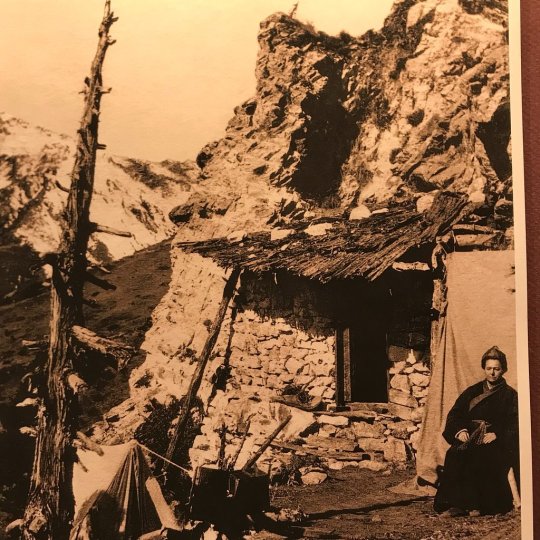
In 1937 Alexandra was now 69 years old, most people would be entering the third stage of their life, but not Alexandra; She had spent a good 12 years in Digne-les-Bagnes, making improvements on her home, expanding a portion of the structure to which she named the “Samtem Dzong” or “Fortress of Meditation”. The purpose of this structure was for the teaching of mediation making it the first Lamaist Temple in the west and it would later become part of her museum.
At this point in her life she was ready to return to her beloved Tibet and to travel through China in order to study Taoism which is the Chinese form of Tantra. This time she decided to take the Trans Siberian Express so she could enter Tibet through the Northern route. But as the fates would have it, for the second time in her life, she was caught once again in the midst of a worldwide conflict: The war between China and Japan. This event was to be a precursor to World War II and it’s ironic to think that Alexandra who many considered to be a warrior for peace, was now compelled to witness the horrible atrocities that were committed by both sides. But always wanting to make herself useful, she actually worked as a medic and a healer for both sides of the conflict.
Finally in 1938, after a year of navigating the conflicts of WW2, she was able to at last enter Tibet, where she visited monasteries, studied sacred scriptures and settled down in the village of Kangdin for what was to become five years retreat of solitary meditation. It was at the end of these five years when she learned that her husband had passed away. It was now 1946, she had been wandering through China and Tibet for 9 years. It was time to return to France in order to tend to the estate of her deceased husband. So she left Tibet via India this time, departing on a new invention called the jet plane which flew her back to Paris.
Now back in France, Alexandra settled her husband’s affairs. She stayed in at Digne-le-Bains where the accolades began to pour in as a result her accomplishments. The French government named her a Chevalier of the French Legion of Honor. She was awarded the Gold Medal by Geographical Society of France. There were streets and schools named after her. Alexandra David-Neel became the foremost authority on Tibetan Tantric Buddhism.
But fate was to give Alexandra one final cruel blow, in 1955 Yongden, her beloved travel companion and now adopted son, died suddenly of kidney failure. The years of hardship traveling under impossible conditions took its toll on his fragile body. Alexandra was heartbroken, but after cremating his remains, vowed that they would once again return to Tibet. She was now 87 years old. Even though her body was showing signs of wear and tear, there were many who said she looked younger due to her lifestyle of yoga and meditation. She continued writing, translating, teaching and became known as the “Wise Lady of Digne”. Buddhist scholars from all over the world made the pilgrimage to her house in Provence to sit at her feet and drink from her well of wisdom.
Finally, at the age of 100, she felt the need to return to Tibet and so went about filing the papers to obtain her travel visa. On September 8, 1969, she transitioned to the next Bardo a month shy of her 101st birthday and just as her travel visa was approved by the Chinese government. Her body was cremated and her ashes, along with those of Yongden, were taken by her followers to Varanasi India so they could be thrown into the Ganges River.
I would like to think that her ashes traveled the Shakti trajectory of the Ganges to the Himalayas, where her Spirit roams the sacred mountain passes as the Lamani, Kadoma, Flying Sky Dakini, always everywhere and nowhere.
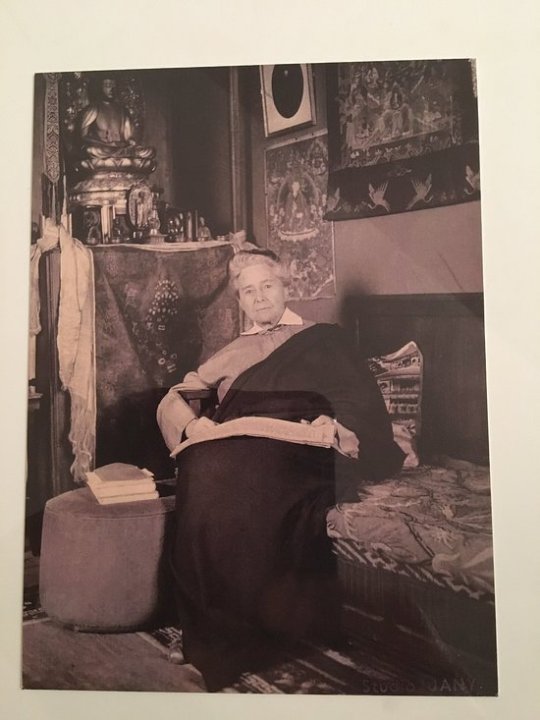
Did you enjoy this Blog? For more information, please visit my website: universaltantra.org or you can contact me by email: [email protected] or by phone: +1 (832) 743-8148
5 notes
·
View notes
Text
Carcinisation - Wikipedia
Porcelain crabs resemble crabs, but are more closely related to squat lobsters and hermit crabs
In evolutionary biology, carcinisation (or carcinization) is a hypothesised process whereby a crustacean evolves into a crab-like form from a non-crab-like form. The term was introduced by L. A. Borradaile, who described it as "one of the many attempts of Nature to evolve a crab".[1]
Carcinisation is believed to have occurred independently in at least five groups of decapod crustaceans[2], most notably king crabs,[3][4] which most scientists believe evolved from hermit crab ancestors. The other examples are the family Porcellanidae, or porcelain crabs (which are closely related to squat lobsters),[5] the hairy stone crab Lomis hirta,[6] the coconut crab Birgus latro, and true crabs.[7] The example of king crabs (family Lithodidae) evolving from hermit crabs has been particularly well studied and, although some doubt this theory, there is considerable evidence in its favour. For example: most hermit crabs are asymmetrical, so that they fit well into spiral snail shells; the abdomens of king crabs, even though they do not use snail shells for shelter, are also asymmetrical.[8][9][10][11]
An exceptional form of carcinisation, termed "hypercarcinisation", is seen in the porcelain crab Allopetrolisthes spinifrons.[12] In addition to the shortened body form, A. spinifrons also shows similar sexual dimorphism to that seen in true crabs, where males have a shorter pleon than females.[12]
References
Jump up ^ Patsy A. McLaughlin; Rafael Lemaitre (1997). "Carcinization in the anomura – fact or fiction? I. Evidence from adult morphology". Contributions to Zoology. 67 (2): 79–123. PDF
Jump up ^ Jonas Keiler; Christian S. Wirkner; Stefan Richter (2017). "One hundred years of carcinization – the evolution of the crab-like habitus in Anomura (Arthropoda: Crustacea)". Biological Journal of the Linnean Society. 121: 200–222. doi:10.1093/biolinnean/blw031.
Jump up ^ Jonas Keiler; Stefan Richter; Christian S. Wirkner (2013). "Evolutionary morphology of the hemolymph vascular system in hermit and king crabs (Crustacea: Decapoda: Anomala)". Journal of Morphology. 274 (7): 759–778. doi:10.1002/jmor.20133.
Jump up ^ Jonas Keiler; Stefan Richter; Christian S. Wirkner (2015). "The anatomy of the king crab Hapalogaster mertensii Brandt, 1850 (Anomura: Paguroidea: Hapalogastridae) – new insights into the evolutionary transformation of hermit crabs into king crabs". Contributions to Zoology. 84 (2): 149–165.
Jump up ^ Jonas Keiler; Stefan Richter; Christian S. Wirkner (2014). "Evolutionary morphology of the organ systems in squat lobsters and porcelain crabs (Crustacea: Decapoda: Anomala): an insight into carcinization". Journal of Morphology. 276: 1. doi:10.1002/jmor.20311.
Jump up ^ Jonas Keiler; Stefan Richter; Christian S. Wirkner (2016). "Revealing their innermost secrets: an evolutionary perspective on the disparity of the organ systems in anomuran crabs (Crustacea: Decapoda: Anomura)". Contributions to Zoology. 85 (4): 361–386.
Jump up ^ C. L. Morrison; A. W. Harvey; S. Lavery; K. Tieu; Y. Huang; C. W. Cunningham (2001). "Mitochondrial gene rearrangements confirm the parallel evolution of the crab-like form" (PDF). Proceedings of the Royal Society B: Biological Sciences. 269 (1489): 345–350. doi:10.1098/rspb.2001.1886. PMC 1690904 . PMID 11886621.
Jump up ^ C. W. Cunningham; N. W. Blackstone; L. W. Buss (1992). "Evolution of king crabs from hermit crab ancestors". Nature. 355 (6360): 539–542. Bibcode:1992Natur.355..539C. doi:10.1038/355539a0. PMID 1741031.
Jump up ^ Patsy A. McLaughlin; Rafael Lemaitre; Christopher C. Tudge (2004). "Carcinization in the Anomura – fact or fiction? II. Evidence from larval, megalopal and early juvenile morphology". Contributions to Zoology. 73 (3): 165–205.
Jump up ^ Ling Ming Tsang; Tin-Yam Chan; Shane T. Ahyong; Ka Hou Chu (2011). "Hermit to king, or hermit to all: multiple transitions to crab-like forms from hermit crab ancestors". Systematic Biology. 60 (5): 616–629. doi:10.1093/sysbio/syr063. PMID 21835822.
Jump up ^ Rafael Lemaitre; Patsy A. McLaughlin (2009). "Recent advances and conflicts in concepts of anomuran phylogeny (Crustacea: Malacostraca)" (PDF). Arthropod Systematics & Phylogeny. 67 (2): 119–135.
^ Jump up to: a b Alexandra Hiller; Carlos Antonio Viviana; Bernd Werding (2010). "Hypercarcinisation: an evolutionary novelty in the commensal porcellanid Allopetrolisthes spinifrons (Crustacea: Decapoda: Porcellanidae)" (PDF). Nauplius. 18 (1): 95–102. Archived from the original (PDF) on 2012-04-25.
(via Carcinisation - Wikipedia)
1 note
·
View note
Photo





Day 16: Relaxation Station I think I got up this morning around 9:15am, and I was immediately hit by all of the fun memories of the night before, which was a great feeling since I normally wake up to the thoughts "Oh god no, not again." Carolina and Natasha were already off at breakfast, and there was only one key so I couldn't go as well or we wouldn't be able to lock the door to our room (they're physical keys here and the doors don't lock behind you), so I skipped breakfast and got ready instead. They showed up a little before when breakfast ended, and we decided that it would be a pool-first and exploration-second kind of day. So I changed into my suit and we made our way up a ramp to the second pool of the hotel (the first was on the other side up by the reception office). We claimed some sun beds and laid out to chill. I had brought my music player with me this time, so I plugged in and listened to some music in the sun for a while before Kristen and Ashley showed up and she insisted I go in with her (because of the Kristen bond, of course). So we spent some time swimming and chatting (and yes, the water was cold). After that, we took turns showering and got into our adventuring clothes. After an eternity of "well I'm good with whatever you guys want to do," we decided to head over to the market down the street to see if they had any cheap, easy food we could take with us on the bus. Unfortunately, they didn't, so Carolina and I bought new water bottles and we went out to the bus stop to check the time-table. Also unfortunately, the timetable was almost impossible to decipher, so we decided to wait until the bus of people from the morning excursion (Volcano hiking) got back so we could ask Alexandra how to get to the places we wanted to go via bus. They bus came while we were walking and we found out that basically that bus only goes to Fira. Which means the only thing I was excited about in Santorini (finding the lost ruins of Atlantis) wasn't going to happen because that was in the completely other direction. So we decided to have lunch at one of the beach restaurants (today we checked out the "Pleasure Bar") and then head to Fira, and subsequently up to Oia, where we would be able to take the tour bus back with the second excursion group (wine tasting and sunset viewing) around 10pm or so. I had a chicken Caesar salad which was super yummy (but damn, they put a lot of things on their salads here!), and then we headed back out to the bus stop. After walking there for 25 minutes or so, I realized that I had absolutely no want to go. It was Day 16, I wasn't going to be able to see the ruins and I was tired, and there was a lot of friendship tension after last night that Nat didn't want to talk about (as we still haven't, which is straining) with Carolina around, so I just knew I wouldn't have fun if I went out. So I asked them for the key and headed back to our hotel for the day. It's currently going on 9pm and I had a very relaxing day which is making me realize how much I need my own bed and my own place again. 20 days is a long vacation and a long time without personal space. As a hermit-introvert, I haven't had hardly a minute to recharge this entire trip and it's been draining. Yes, the trip is amazing. I adore everything I'm getting to see and all of the things I'm getting to do and all of the people I'm meeting (well..not all of them--looking at you, Plastics), but it's a long time away and a lot of energy expelled. I was able to get a bit of that back today, as I spent some time Facetiming my mom and the majority of the afternoon out by the pool sunbathing and reading (and subsequently falling asleep) on one of the sun beds. Now I'm finishing up my blog posts, watching How to Get Away With Murder, and repainting my nails so they aren't so barked up and chipped. We leave tomorrow morning on a ferry to Paros (the island where Greeks go to vacation), which will be a lot of beach time, which is exciting. I've definitely got quite a bit of a tan already, so another two days laying on beaches in the sun will definitely cement my no-longer-pasty-as-the-moon-ness! Huzzah~! I've gotten some sun for once!! I'll update more tomorrow, per usual. Ta ta!
0 notes
Text
;; Tag dump part one.
#;; 0. THE FOOL [Ayna]#;; 1. THE MAGICIAN [Everett]#;; 2. THE HIGH PRIESTESS [Lianne Bardot]#;; 3. THE EMPRESS [Arsene Bardot]#;; 4. THE EMPEROR [Terran Obsidian]#;; 5. THE HIEROPHANT [Marc]#;; 6. THE LOVERS [Luukas]#;; 7. THE CHARIOT [Delta]#;; 8. THE JUSTICE [Silva]#;; 9. THE HERMIT [Alexandra]#;; 10. THE WHEEL OF FORTUNE [Fostor]
0 notes